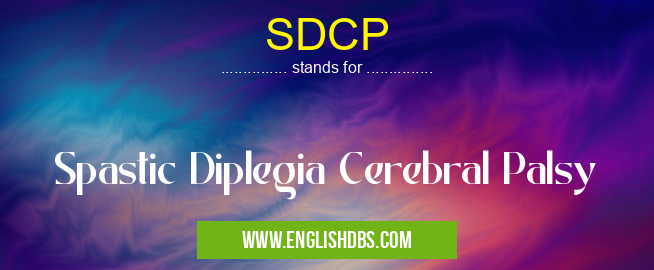What does SDCP mean in DISABILITY
Spastic Diplegia Cerebral Palsy (SDCP) is a type of cerebral palsy, a disorder in motor function caused by brain damage. SDCP causes spasticity and muscle stiffness in the legs, leading to difficulties with movement, coordination and posture. People with SDCP may have associated issues such as seizures or hearing loss.

SDCP meaning in Disability in Medical
SDCP mostly used in an acronym Disability in Category Medical that means Spastic Diplegia Cerebral Palsy
Shorthand: SDCP,
Full Form: Spastic Diplegia Cerebral Palsy
For more information of "Spastic Diplegia Cerebral Palsy", see the section below.
» Medical » Disability
Essential Questions and Answers on Spastic Diplegia Cerebral Palsy in "MEDICAL»DISABILITY"
What is Spastic Diplegia Cerebral Palsy?
Spastic diplegia cerebral palsy (SDCP) is a type of cerebral palsy that affects motor function, usually appearing during early childhood. Specifically, it causes an increase in muscle tone and stiffness in the legs, which can lead to problems with coordination and movement.
What are the signs of SDCP?
Signs of SDCP can include difficulty walking due to spasticity and stiff muscles in the legs, awkwardness when sitting or standing upright, unsteadiness when running or walking up stairs, and unusually shaped feet such as club foot or toe walking.
Is there any treatment for people with SDCP?
There is no cure for SDCP however there are treatments available to help manage symptoms. These include physical therapy to help improve strength and flexibility, occupational therapy to help improve fine motor skills, medications to address pain or spasticity, assistive devices such as splints or braces for support while walking or standing, orthopedic surgery if needed to reposition bones and release contracted muscles.
Can children with SDCP go on to lead normal lives?
With proper management of symptoms through treatments like those mentioned above, many individuals with SDCP can lead active and productive lives just like other children their age. It is important that families have access to resources that provide support and advice if needed along the way.
Final Words:
Spastic Diplegia Cerebral Palsy is a neurodevelopmental disorder that affects movement but does not have to be limiting for everyday life activities if managed well through appropriate treatments including physical therapy exercises and assistive devices where needed. With proper management people with SDPC should be able to live full lives despite their condition.
